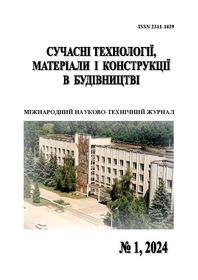PROSPECTS OF USE OF SECONDARY WASTE OF THE CONSTRUCTION INDUSTRY IN THE PRODUCTION OF DRY BUILDING MIXTURES
DOI:
https://doi.org/10.31649/2311-1429-2024-1-64-70Keywords:
construction, waste, dry construction mixtures, secondary waste, solutions, concrete, reuse, resource conservation,, environmental friendlinessAbstract
The work considers the actual problem of creating effective dry construction mixes (DBC) for a wide range of construction works, in particular for external and internal plaster coatings. The main attention is paid to the study of the effect of finely dispersed mineral additives, such as diatomite, white carbon black (amorphous microsilica) and limestone powder, on the physical and mechanical properties of SBS. In the study, two working compositions of SBS based on cement binder with different types of sand were used: quartz, polymict, and screening of crushed limestone.
The results of experimental studies showed that the introduction of Tylose cellulose esters significantly increases the water-holding capacity of mortar mixtures to 99.4-99.7%. However, despite the increase in water holding capacity, these mixtures do not reach the required strength for the grade above M100 without increasing the amount of binding material. At the same time, the introduction of C-3 superplasticizer effectively reduces the water-cement ratio (W/C), which helps to increase the strength of the hardened solution and allows to achieve the required strength indicators even for the M150 grade.
Active mineral additives, such as finely ground limestone, stabilize the cement paste and help reduce delamination of the mixture. Additive grains fill the spaces between cement grains, increasing the packing density of solid components and, thus, improving the structuring of artificial stone. This helps to increase the strength and reduce the shrinkage of solutions.
It is also important that the use of local raw materials, such as waste from stone mining and sandstone processing, allows to significantly reduce the cost of production of dry building mixes. The use of these materials provides not only economic benefits, but also helps reduce the environmental burden due to waste disposal.
The results of the study confirm the perspective of using carbonate finely dispersed mineral additives as part of dry construction mixtures, which allows to improve their physical, mechanical and technological properties. This opens up new opportunities for creating effective building materials that meet modern requirements of quality and economic efficiency.
References
DSTU B V.2.7-126:2011. Dry modified construction mixes. General technical conditions. [Effective from 2011-06-01]. Kind. officer K.: Ministry of Regional Development and Construction of Ukraine, 2011. 42 p.
Usherov-Marshak O.V., Latorets K.V. Concretes and cyxi building mixtures. Dictionary. Kharkiv: Kolorit, 2010. 104 p
Runova R.F., Nosovitsky Yu.L. Technology of modified construction mortars. Textbook. KNUBA, 2007. 250 p.
Troyan V.V. Additives for concrete and construction mortars: a study guide. Nizhin: LLC "Aspect-Polygraph Publishing House", 2010. 228 p.
Dobryanskyi I.M., Nionets I.I. Influence of the microstructure of cement stone on its physical and mechanical properties. Building of Ukraine, No. 3, 2009. P. 35-36.
Kryvenko P. V. Building materials science: textbook. Kyiv, Ukraine: Lira-K Publishing House, 2019. 694 p.
Kropyvnytska T. P., Sanytskyi M. A., Gev'yuk I. M. Influence of carbonate additives on the properties of composite portland cement. Bulletin of the National University "Lviv Polytechnic": Theory and practice of construction, No. 755, 2013. P. 214-220.
Rusyn B. G. Highly functional concretes based on Portland cement modified with ultradisperse mineral additives: Ref. thesis Ph.D. of science Lviv Polytechnic National University, Lviv, Ukraine, 2014.
Gev'yuk I.M., Kropyvnytska T.P., Sanytskyi M.A. Composite Portland cements with additions of natural zeolite and limestone. Resource-saving materials, constructions, buildings and structures, Vol. 31, 2015. C. 149-156.
DSTU B V.2.7-171:2008. Building materials. Additives for concrete and mortars. General technical conditions. [Effective from 2009-01-01]. Kind. officer K.: Ministry of Regional Construction of Ukraine, 2010. 93 p.
DSTU B V.2.7-46:2010. Building materials. Cements for general construction purpose. Specifications. [Effective from 2011-09-01]. Kind. officer K.: Ministry of Regional Construction of Ukraine, 2011. 20 p.
DSTU B V.2.7-27-95. Sand from shell limestones for construction works. Specifications. [Effective from 1996-01-01]. Kind. officer K.: State Construction Committee of Ukraine, 1996. 8 p.
DSTU B V.2.7-29-95. Small aggregates are natural, from industrial waste, artificial for building materials, products, constructions and works. Classification. [Effective from 1996-01-01]. Kind. officer K.: State Committee for Construction of Ukraine, 1996. 17 p.
DSTU B V.2.7-128:2006. Building materials. Active mineral additives and filler additives for cement. [Effective from 01-12-2007]. Kind. officer K: Ministry of Construction, Architecture and Housing and Communal Services of Ukraine, 2006. 12 p.
Downloads
-
pdf (Українська)
Downloads: 0



